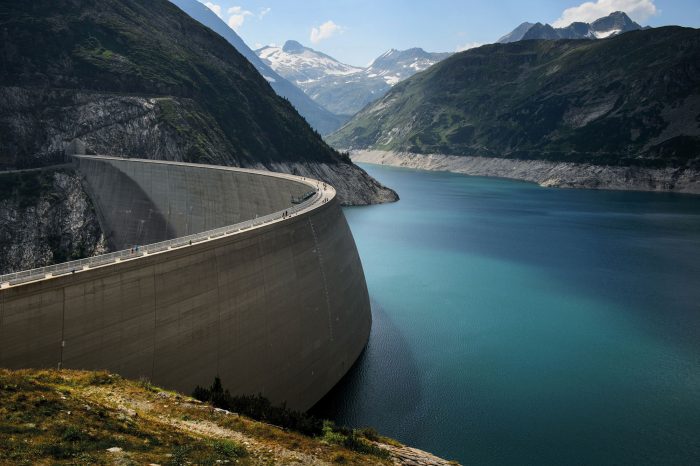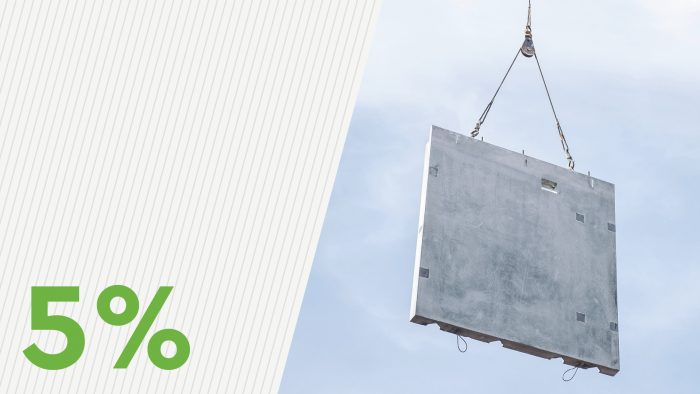Concrete is essential for our modern world. It is not only the world’s most used building material, it is the world’s most used material in general after water for a reason – it is abundant, affordable, locally available and can be used in innumerable ways.
The world’s population is growing, with an ever-larger number of people making cities their home. The task of sustainably providing housing, energy, transportation and other basic services to this rising number of urban dwellers in the face of climate change is vast. Already today, close to three in five cities of 500,000 inhabitants or more – home to about 1.4 billion people – are at high risk of natural disaster.
Concrete’s remarkable properties make it a vital element in both limiting the scope, and combating the effects of climate change – enabling the development of sustainable and resilient building and communities around the world.
Click on an icon to find out more:
The Climate and Biodiversity Challenge
We recognise there are two existential challenges facing our world –
- climate change; and
- the crisis in the natural world impacting its biodiversity.
On climate change, the cement and concrete industry has worked over many years to reduce its CO2 emissions. Our member companies, which operate in almost every county of the world, recently committed to accelerating that progress. In 2020 we came together as leaders in the sector to commit to a climate ambition of producing carbon neutral concrete by 2050, in line with global climate targets. In protecting the natural world and promoting biodiversity, we have a proud record of good practices in positive land stewardship.
On biodiversity, our members have recently underpinned this longstanding work with the announcement of a key aim towards the achievement of Net Positive Impact in their cement, concrete and aggregates operations.
Our land requirement footprint is proportionally very small in relation to the requirements of other building materials (such as timber which requires vast tracts of monoculture land).
Concrete’s sustainability benefits
When taking the performance of a building over its whole lifecycle into account, concrete offers significant sustainability benefits over other building materials thanks to its innate properties, such as its strength, durability, resilience to extreme weather and hazards such as fire, its thermal mass, its recyclability, its carbon uptake and its local availability.
Strength, Durability, Resilience and Safety

Society expects the built environment – buildings, bridges and other infrastructure – to be enduring and safe – safety is the first priority. There is also an expectation of resilience in the face of disasters, whether natural disasters or other events, and for buildings, bridges and infrastructure to last a long time. Concrete is well known for its attributes of strength, durability, resilience and safety – concrete for example does not burn.
Key sustainability benefits:
Carbon Emissions and Circularity

Concrete has excellent sustainability qualities, and the industry has made significant progress in reducing its CO2 emissions from cement manufacture. The cement industry has reduced its carbon emissions by 19% since 1990 (GCCA in Numbers, 2020). The industry also launched Climate Ambition to provide society with carbon neutral concrete by 2050, in line with global climate targets. Today, concrete suppliers and designers, and in turn their clients and customers, can use concrete to minimise carbon footprints by: optimising mix, the efficient use of materials and recognising the carbon uptake potential of concrete to permanently sequester CO2 in buildings. Concrete can also be reused and at end of life is 100% recyclable.
Key sustainability benefits:
Biodiversity

Biodiversity is critical to the health of our planet – it is vital that we limit our impact on the earth. The cement and concrete industry has a longstanding commitment to improving and enhancing biodiversity in the areas that it operates.GCCA members aim for net positive impact on the land they use as part of our Sustainability Charter, and adhere to our biodiversity guidelines and policies around land use.
Key sustainability benefits
Local

Concrete is a product with raw materials locally available. The key ingredient of cement (approx. 10-15% of concrete by weight) is based on limestone which is widely and abundantly available. This means that there is significant carbon savings in transportation, as the material does not need to be traded across long distances.
Key sustainability benefits:
Versatility and Design

Concrete is the ideal building material for a wide range of applications because of its versatility. It can be moulded into an infinite number of shapes and maintain its strength, allowing designers to use it for a range of uses.
Designers and constructors have a role to play
Their roles include:
- Ensuring optimum specification of concrete mix given desired function
- Utilising the versatility of form
- Maximising efficiency of design and structural material utilisation
- More than just structure – using thermal mass, minimising finishes
The inherent performance properties of concrete mean designers can deliver sustainable projects
In-use Performance
| Environmental | Social | Economic | |
| Fire Resistance | Concrete does not burn. Therefore it reduces both the waste of materials and the noxious emissions caused by fire. | Concrete does not burn. Therefore it reduces both the waste of materials and the noxious emissions caused by fire. | Concrete does not burn. Therefore it reduces both the waste of materials and the noxious emissions caused by fire. |
| Durability | Due to the long life of all concrete structures, material impacts on the environment are kept to an absolute minimum. | The durability of concrete structures means that, once built, they are rarely out of use for maintenance and hence cause minimum social disruption. | Concrete is a very stable and durable material with an extremely long life. As a result, maintenance costs are extremely low for concrete structures. |
| Acoustic Performance | Concrete has good acoustic performance and there is less reliance on finishes and materials which have a short lifespan. Hence less material is used and potential waste is avoided. | Concrete’s mass absorbs sound, ensuring quality of life, particularly in high density living, where noise from neighbours can be a major issue. | Concrete walls and floors provide the required acoustic separation with minimum finishes, and therefore minimal costs and maintenance. |
| Acoustic Performance | Concrete structures are robust, reducing the risk of damage to finishes. Therefore, less material is used throughout a structure’s lifecycle. | Solid concrete masonry and party walls provide safe, secure buildings. Prevention of intruders helps to build safer communities. | Concrete structures, particularly those with minimal finishes, will suffer less damage and cost less to repair and maintain. |
| Flood resilience | Concrete retains its structural integrity, resulting in minimal waste of materials following a flood event. | Concrete and masonry structures can be designed to resist water penetration, keeping inconvenience and disruption to business, homeowners and the community to a minimum. | Downtime of businesses, homes and essential community services is minimised if flooded buildings have been constructed in concrete. |
| Thermal Mass | Concrete’s thermal mass allows it to be used to reduce buildings’ heating and cooling energy load, thus reducing operational carbon. | The thermal mass inherent in concrete provides a simple and effective means to reduce overheating for those who do not have air conditioning. Overheating is a growing health and wellbeing issue, particularly among the elderly. | Using the thermal mass of concrete will lower running costs of a building. It will also reduce the plant needed on site, leading to lower operating and maintenance costs. |





















